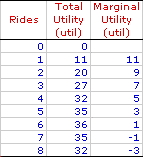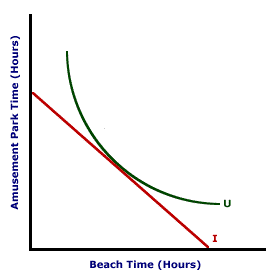
|
|
BUDGET CONSTRAINT: The alternative combinations of two different goods that can be purchased with a given income and given prices of the two goods. This budget constraint, also termed budget line, plays a major role in the analysis of consumer demand using indifference curve analysis. Indifference curves represents the "willingness" aspect of consumer demand, the budget constraint captures the "ability". One key consumer demand topic is to analyze how consumer equilibrium is affected by changes in the price of one good. Then end result of this analysis is a demand curve. For more fascinating uses of the budget constraint and indifference curves, and consumer demand analysis, see income-consumption curve and price-consumption curve.
Visit the GLOSS*arama
|
|


|

|
                           CONSUMER DEMAND THEORY: The branch of economics devoted to the study of consumer behavior, especially as it applies to decisions related to purchasing goods and services through markets. Consumer demand theory is largely centered on the study and analysis of the utility generated from the satisfaction of wants and needs. The key principle of consumer demand theory is the law of diminishing marginal utility, which offers an explanation for the law of demand and the negative slope of the demand curve. Consumer demand theory provides insight into an understanding market demand and forms a cornerstone of modern microeconomics. In particular, this theory analyzes consumer behavior, especially market purchases, based on the satisfaction of wants and needs (that is, utility) generated from the consumption of a good.A basic version of this theory, primarily taught in introductory courses, involves the analysis of total and marginal utility, especially the role played by the law of diminishing marginal returns. A more sophisticated version of the theory, more commonly found at the intermediate course level and above, relies on the analysis of indifference curves and relative utility, with a key role play by decreasing marginal rate of substitution. Both versions provide insight into the law of demand and the negative slope of the demand curve. Doing DemandDemand, the willingness and ability to purchase a range of quantities at a range of prices, is one half of the market. The law of demand, which gives rise to a negatively-sloped demand curve, is an essential principle underlying market analysis. Modern microeconomic theory, among other topics, is concerned with understanding and explaining the law of demand.Insight into this law can be found with consumer demand theory. The explanation is relatively simple--on the surface. Consumers purchase goods that satisfy wants and needs, that is, generate utility. Those goods that generate more utility are more valuable to consumers and thus buyers are willing to pay a higher price. The key to the law of demand is that the utility generated declines as the quantity consumed increases. As such, the demand price that buyers are willing to pay decreases as the quantity demanded increases. A Little HistoryThe notion that market demand depends on the satisfaction of wants and needs has been an essential part of the economic analysis of markets since at least the time of Adam Smith. However, three scholars working in progression from the late 1700s to the late 1800s gave the development of consumer demand theory a large, formal boost.- Jeremy Bentham: The first major advance in the development of consumer demand theory was provided by Jeremy Bentham in the late 1700s. Bentham coined the term "utility" in reference to the satisfaction of wants and needs. He also developed the notion that people are motivated by the desire to maximize utility. Bentham firmly believed that utility was a measurable, quantifiable characteristic of a person, much like height or weight.
- John Stuart Mill: The theoretical work developed by Bentham was extended and popularized by John Stuart Mill, whose father James Mill was a contemporary and close friend of Bentham. The elder Mill introduced the younger Mill to the thoughts and teachings of Bentham at an early age. John Stuart Mill expanded and promoted these consumer demand principles in a number of publications, including his book, Principles of Political Economic, which was the dominate economics textbook for several decades.
- William Stanley Jevons: A major improvement in consumer demand theory was provided by William Stanley Jevons with the notion of marginal utility. Jevons also developed the rule of consumer equilibrium, stating that consumers purchase goods such that the ratio of marginal utilities is equal to the ratio of prices. Along the way, Jevons helped to transform consumer demand theory (as well as microeconomics in general) into a rigorous mathematical science.
Utility| Utility Analysis |  |
A basic formulation of consumer demand theory involves an analysis of the total utility and marginal utility derived from the consumption of a good. The focal point of utility analysis is usually a table of the total and marginal utility generated by consuming different quantities of a good, such as the one displayed in the exhibit to the right.This analysis is based on the presumption that the amount of utility generated from the consumption of a good can be explicitly measured. The standard measurement unit is "utils." This particular set of numbers illustrates the total and marginal utility generated by riding a roller coaster at the local amusement park. The key bits of information presented in this table are: - First, the far left column presents the number of rides on the roller coaster, which is the quantity of the good consumed. It increases from 0 hours to 8 rides.
- Second, the middle column indicates the total utility, or the cumulatively amount of utility, obtained from the rides. For example, taking 3 roller coaster rides generates 27 utils of total utility. Most notably, total utility generally increases with the number of rides. However, it does reach a maximum for the 6 rides, then declines.
- Third, the far right column shows marginal utility, or the amount of additional utility derived from each extra ride. For example, because 2 rides generates a total utility of 20 utils and 3 rides generates a total utility of 27 utils, the amount of extra utility generated by taking the third ride on the roller coaster is 7 utils.
- Fourth, marginal utility in the far right column declines with additional rides on the roller coaster. This reflects the law of diminishing marginal utility, the key economic principle underlying utility analysis.
The Law of Diminishing Marginal UtilityThe law of diminishing marginal utility states that marginal utility, or the extra utility obtained from consuming a good, decreases as the quantity consumed increases. In essence, each additional good consumed is less satisfying than the previous one. This law is particularly important for insight into market demand and the law of demand.If each additional unit of a good is less satisfying, then a buyer is willing to pay less. As such, the demand price declines. This inverse law of demand relation between demand price and quantity demanded is a direct implication of the law of diminishing marginal utility. Indifference Curves| Indifference Curve Analysis |  |
A more advanced form of consumer demand theory involves the analysis of indifference curves. An indifference curve, such as the one labeled U in the exhibit to the right, presents all combinations of two goods that provide the same amount of utility. Hence a consumer is "indifferent" between consuming any combination of the two goods anywhere on the curve.Indifference curve analysis relies on a relative ranking of preferences between two goods rather than the absolute measurement of utility (utils) derived from the consumption of a particular good. Key bits of insight obtained from this diagram are: - First, the indifferent curve representing equal utility obtained from any consumption combination of the two goods (time at the beach and time at an amusement park) is represented by U.
- Second, the consumer is faced with an income or budget constraint, I, which shows the alternative combinations of the two goods that the buyer can purchase given a specific amount of income and existing prices.
- Third, the negative slope of the budget constraint reflects the tradeoff between the consumers ability to purchase the two goods. Purchasing more of one good necessarily means the consumer must purchase less of the other.
- Fourth, the negative slope and convex shape of the indifference curve reflects the tradeoff between the consumers willingness to purchase the two goods. In particular, the convex shape reflects the decreasing marginal rate of substitution between the two goods.
Decreasing Marginal Rate of SubstitutionThe decreasing marginal rate of substitution means that a consumer is willing to give up increasingly smaller quantities of one good in order to obtain more of another good. The reason is that as more of a good is consumed it becomes relatively less satisfying.A decreasing marginal rate of substitution generalizes the law of diminishing marginal utility. However, rather than stating that the incremental satisfaction declines absolutely, it states that incremental satisfaction declines relative to that obtained from other goods. Moreover, like the law of diminishing marginal utility, the decreasing marginal rate of substitution used in indifference curve analysis provides insight into market demand and the law of demand. If a good generates less relative satisfaction, then a buyer is wiling to pay a relatively lower price, which also explains the inverse law of demand relation between demand price and quantity demanded. Applying the TheoryConsumer demand theory is primarily directed toward an understanding of market demand and the law of demand. However, it provides a great deal of insight into all sorts of human behavior and activities. A short list includes:- Labor Supply: Insight into the quantity of labor that workers are willing to supply at different wages can be obtained with consumer demand theory by analyzing the tradeoff between labor and leisure activities.
- Household Production: In a similar manner, insight into the amount of work performed around the house, without explicit compensation, be analyzed using consumer demand theory.
- Crime: The choice between committing a crime and not committing a crime can also be investigated using consumer demand theory, with the "price" paid for criminal activities based on the probability of being caught and punished.
- Voting: The amount of time and effort devoted to voting in elections has also been subjected to analysis using consumer demand theory.
A complete list of areas that have been or can be analyzed and better understood using consumer demand theory is limited only by the choices people make and the types of activities they pursue. In essence, consumer demand theory can be applied to virtually any form of human behavior that involves a tradeoff and a choice.

Recommended Citation:CONSUMER DEMAND THEORY, AmosWEB Encyclonomic WEB*pedia, http://www.AmosWEB.com, AmosWEB LLC, 2000-2025. [Accessed: July 5, 2025].
Check Out These Related Terms... | | | | | | | | |
Or For A Little Background... | | | | | | | | |
And For Further Study... | | | | | | | |
Search Again?
Back to the WEB*pedia
|



|

|
RED AGGRESSERINE
[What's This?]
Today, you are likely to spend a great deal of time at the confiscated property police auction trying to buy either a remote controlled sports car with an air spoiler or semi-gloss photo paper that works with your neighbor's printer. Be on the lookout for empty parking spaces that appear to be near the entrance to a store.
Your Complete Scope
This isn't me! What am I?
|

|
|
The average length of a "business lunch" is about 36 minutes.
|

|
|
"Plans are only good intentions unless they immediately degenerate into hard work." -- Peter Drucker, management consultant
|

|
AMW
Average Monthly Wage
|

|
|
Tell us what you think about AmosWEB. Like what you see? Have suggestions for improvements? Let us know. Click the User Feedback link.
User Feedback
|


|


